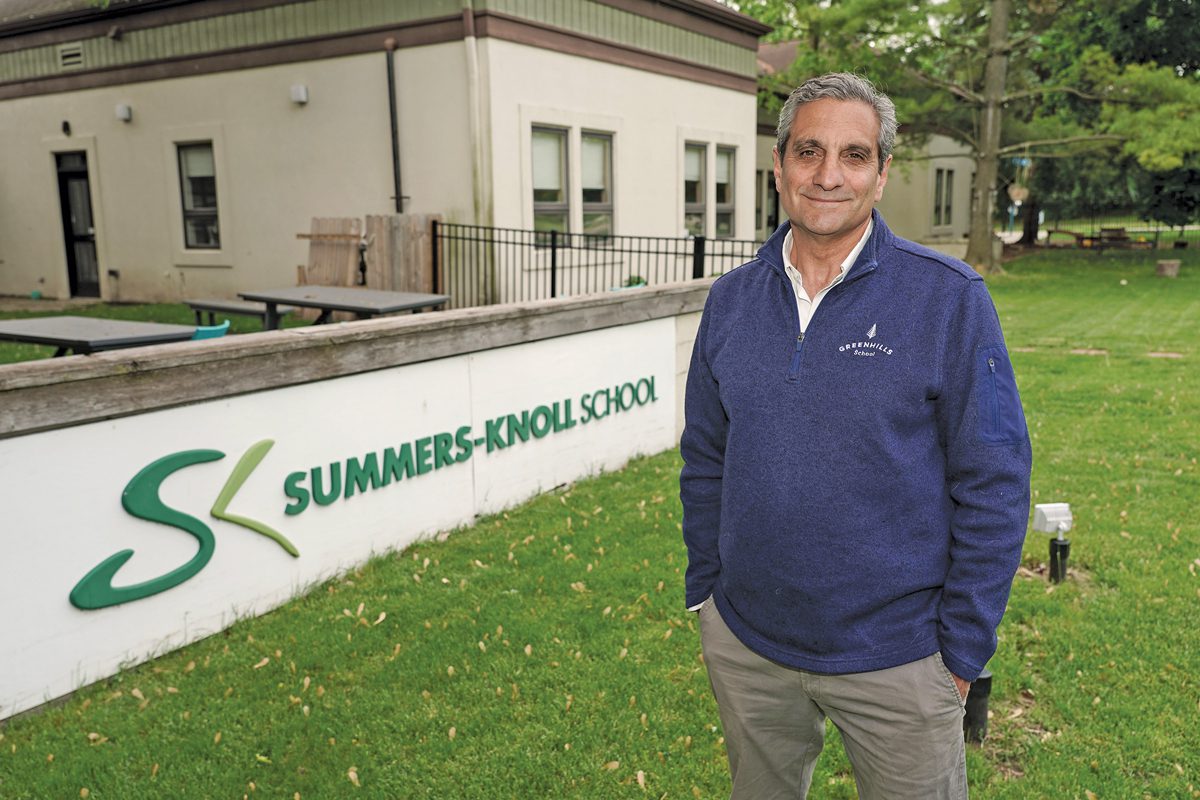
“It wasn’t a sale, per se,” Fayroian says. Greenhills is making payments “so [Summers-Knoll] can continue to operate” until Greenhills rolls out its own lower school program in 2026‒27. | Photo by J. Adrian Wylie
Related: Fayroian Returns
Now he’s overseeing a plan that aims to add 180 younger students on a second campus: the building on Platt Rd. that’s now Summers-Knoll School, a progressive preK–5 independent.
“It wasn’t a sale, per se,” Fayroian says. They’re making payments “so it can continue to operate” until Greenhills is ready to roll out its own lower school program in 2026–2027.
“We haven’t written a check for the building and for all of its assets,” Fayroian adds. “We’ve actually taken on all of their liabilities—their debt.”
“Summers-Knoll’s never had an endowment,” explains Johnathan Letcher, its soon-to-depart head of school. “Like a number of small schools, it was precarious for decades.”
Former head Joanna Hastings, now living in the UK, confirms that when she arrived in 2007, “the school was not doing well at all. It almost closed, but we managed to turn things around” by moving to a larger building.
Thanks to the generosity of founder and namesake Ruth Knoll, the school owned its original building on Manchester Rd. outright. It was sold, and with additional support from Knoll and others, the school was able to get a mortgage to buy and remodel the current building. “Once we were able to move,” Hastings emails, “enrollment rose quickly.”
Since even minor fluctuations in enrollment have a big effect on a small school, she adds, “decisions were sometimes hard. I won’t say it wasn’t stressful, but [when she left in 2016] we were talking about strategies for the future, not closure.”
By the late 2010s, Summers-Knoll was consistently reporting an enrollment of 100 students to the Ann Arbor Observer City Guide. But since then, while Greenhills’ enrollment was growing, Summers-Knoll’s shrank. It has just sixty students this year.
Letcher arrived in 2021. “It was very tight-knit,” he says. “It truly ran like a co-op. So many of the parents in the school were volunteers, they did lunch duty, they did recess.” Some, like board member Ed Feng, even taught classes.
“I absolutely love the school,” says Feng, whose youngest child is graduating this year. “One of my first memories of the school was walking in and a teenager in the middle school looking me straight in the eye and saying, ‘Hello.’
“Kids are happy there. Kids feel secure enough to say hello to a random adult that’s walking through.” Feng likes the school’s absence of letter grades, its project-based learning, and the preparation his kids got for high school. “Unfortunately not everyone else feels the same way I do, “ he adds, “which has been a source of frustration for me.”
Fayroian says that in his brief visits he’s seen “wonderful” teachers at Summers-Knoll. But Letcher says that when he arrived, he noticed a “disconnect” between students’ experiences from grade to grade.
“Could a person guarantee that after reaching a certain grade a child will experience 1-2-3 things?” Letcher asks rhetorically. “Sometimes you could, sometimes you might not be able to—because it was teacher-dependent.”
He was hired, he says, “to bring a structure that was standardized—standard for independent schools.” That included accountability measures like “evaluation of teachers” and establishing “universal expectations of learning.”
Does he feel he achieved his mission? “One hundred percent,” Letcher says. He acknowledges that a contingent of current parents thought “the school was fine the way it was,” and some left.
Another change offset some of the financial loss.“When I got there there was a forty-five percent financial assistance rate and now it’s sixteen,” Letcher says.
But with fewer students, the number paying full tuition—$16,600 to $24,000 this year, depending on grade level—has actually decreased. According to a post on the Summers-Knoll website, the school’s leaders concluded that it faced “insurmountable enrollment and financial challenges.”
Letcher says that when he arrived in 2021, Fayroian asked him how Summers-Knoll was doing, and let him know that Greenhills was looking at opening an elementary school. Late last year, “I made the calculated decision to say, ‘Look, why struggle?’” Letcher says. “I said, ‘Okay, here’s a win-win.’ … We tried different avenues, but to me, this made the most sense.” Fayroian anticipates they’ll eventually have thirty students per grade level, tripling Summer-Knoll’s current head count.
Where does all this leave the school’s current head?
“That’s still up in the air,” Letcher says. His own “trajectory is remaining a head of school. And of course Peter is Greenhills’ head of school, and he should continue doing that.
“So that means then that my next adventure is still to be written.”